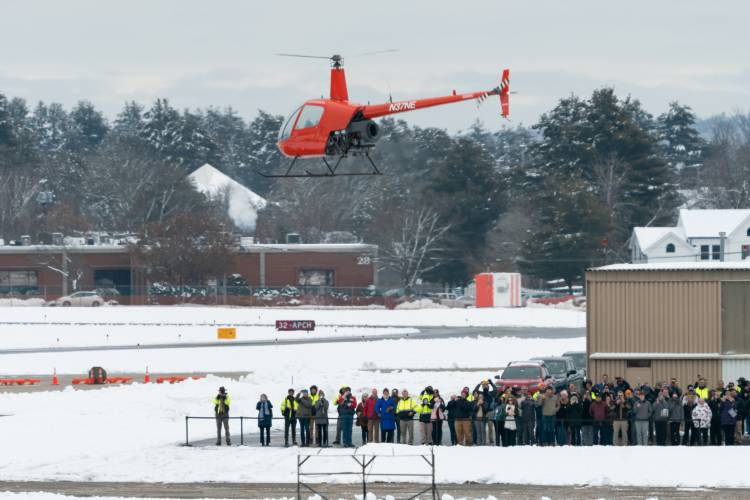Small companies are encouraged to start up near potential customers. So why is Rotor, which hopes to turn small helicopters into autonomous crop-dusting machines for big farms out west, based at Nashua Airport and testing prototypes from a private airstrip in Henniker?
Simple: Boston overflow in action again.
As Rotor CEO Hector Xu told it Tuesday in Nashua, after a successful first public demonstration of the craft that they’ve dubbed “Spirit of New Hampshire,” the company founders began looking for airport space near their home base of MIT in Cambridge, Mass., and kept going outward until somebody had enough room.
That room turned out to be Hangar 9 in Nashua. The company, which now has about 50 employees, has been building prototypes based on Robinson helicopters for two years, taking advantage of being in what Gov. Chris Sununu, an MIT grad himself, semi-jokingly called the “tax-free suburb of Boston” while attending Tuesday’s event.
A bonus has been the amount of space available in the defunct Daniel Webster College across the street from the municipal airport, where Rotor first occupied a dorm and now fills the former college library.
The company’s goal is to build a helicopter that can spray chemicals on crops, drop water on forest fires and perform other tasks without having a trained pilot inside the machine. This would cut costs, as the automation inside the Rotor should reduce the amount of training needed for the operator on the ground, make flight possible in conditions where a pilot wouldn’t be at risk, and reduce the chance of fatal crashes.
On Tuesday, at the company’s public coming-out party that attracted Sununu as well as the media, they showed a video of test flights by uncrewed copters over Intervale in the White Mountains, using pilots sending signals from the ground.
The goal of the privately-funded company is to have commercial sales as early as this year. Among the obstacles will be Federal Aviation Administration approval, starting with permission to do test flights that are out of sight of the ground pilot.
Tuesday’s demonstration certainly went flawlessly. With a crowd of well over 50 people watching at Nashua airport, a helicopter without anybody inside started, rose some 30 feet in the air, hovered for a bit – “Hovering is the hardest part,” said the commentary over a loudspeaker – then flew back and forth over the airport taxiway for a few minutes before gently landing to rousing cheers from the Rotor workers.
Rotor’s approach is to take two- and four-person helicopters from Robinson, a California firm that dominates the small end of the civilian helicopter market, and alter them. They remove the seats, which also removes the incentive to use an on-board pilot if development got too hard, install lots of sensors and a computer, and replace push rods and the pilot’s control stick with a fly-by-wire system.
As Rotor chief engineer David Walker explained it, the basic difficulty is taking ever-changing inputs from a host of cameras, LIDAR and radar units keeping an eye on the surroundings, combining it with data from air-speed sensors, gyroscopes, GPS systems, accelerometers and other devices, then using it all in real-time to determine how to tweak rotor speed and angles to move where the remote pilot wants to go.
“The pilot input might be ‘Roll to the right, move forward, move forward at this velocity’ … and the job of the flight controllers is to see the pilot’s command and manipulate the actuators to achieve the desired result, using feedback from the sensors,” he said.
Which raises the question: Why not use an electric drone with multiple lift rotors, as many start-ups are doing, rather than a traditional helicopter with a tail rotor that was built to carry people?
“Range and payload,” explained Ben Frank, chief commercial operator for Rotor. Helicopters using aviation fuel can fly farther and carry more stuff than any hovering drone, at least under current battery technology.
“10 gallons is not an interesting payload,” Frank said, referring to the top-end capacity most drones can carry.
Rotor’s first model, the R550X, will carry at least 110 gallons and perhaps more, with an estimated 350 nautical mile range.
Helicopters also have the benefit of a century of development, which provides a level of confidence that relatively new drone technology can’t give.
This isn’t the first time that an aeronautical startup from MIT has come over the border. For many years, Nashua Airport was home to Terrafugia, which tried to build and sell a flying car without success. That company was eventually bought by a Chinese firm that shut it down during the pandemic.
For its part, Rotor has no plans to depart any time soon, said Xu, who added a clincher: He has moved here. “I’m now a New Hampshire resident!”


 Return to the Concord Monitor
Return to the Concord Monitor